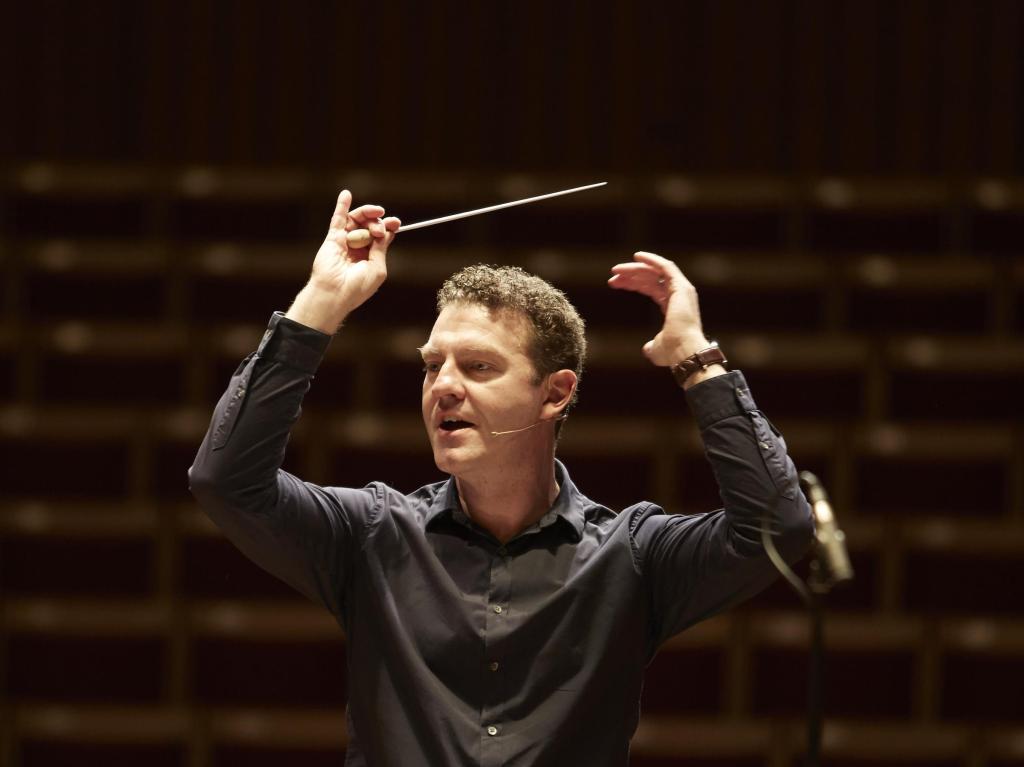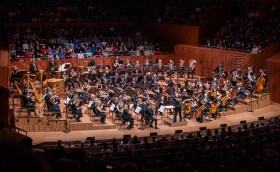Brett Weymark. Photo © Keith Saunders.
On Saturday afternoon, within the vast cream and gold elegance of the Neo-Georgian Centennial Hall of the Sydney Town Hall, we heard a welcome return of Haydn’s large-scale choral and orchestral masterpiece, The Creation. Composed between 1797 and 1798 towards the end of the composer’s life, the work’s nature-centred and arguably pantheistic sentiment rejoices in the supremacy of humanity and provides an exquisite musical celebration of the ideals the Age of Enlightenment. For this performance, the Philharmonia’s large Festival Chorus, meeting just twice a year, was joined by The Metropolitan Orchestra, a versatile and privately-run ensemble now in its tenth year, a distinguished trio of soloists in Taryn Fiebig soprano, Nicholas Jones tenor and Jud Arthur bass all under the direction of Brett Weymark, artistic and music director of Sydney Philharmonia Choirs.
From its first performances, The Creation was a success. Haydn was riding the crest of a wave in popularity across Europe following his London visits in the 1790s and the strong appeal of the excellent symphonies written there. Although first sung in German as ‘Die Schöpfung’ with a fine libretto by Baron Gottfried van Swieten, the text was originally written in English and drawn from Genesis, the biblical book of Psalms and John Milton’s Paradise Lost. It was first published in 1800 with, unusually, a text in both German and imperfect English. Haydn always intended the work as a crowd pleaser in the mould of Handel’s oratorios he had heard in England with their broad appeal. In this work he was drawn to use massed forces for its first public performances. Saturday’s performance followed this intention with a large orchestra and very large chorus of some hundreds.
An effective, efficient and musically generous conductor, Brett Weymark had the The Metropolitan Orchestra (TMO) play with as little vibrato as possible and his tempi were on the brisk side, emulating a period instrument performance. The TMO appeared, however, to be unused to playing without vibrato. From the work’s opening Introduction: The Representation of Chaos, calling for a unison ‘C’ with distant modulations and the inferred but unresolved tonality that follows needing to be finely tuned, there were intonation problems and issues with ensemble and rapport. The caution of the three flutes, pairs of oboes and clarinets was often not met by their colleagues in other sections. The famous exuberant C major outburst to the words ‘And there was light’ was most effective. On stage there was a little fortepiano modelled on one by Stein (appropriate to the period but swamped in this band) and played by Claire Howard Race, who is both a member of the TMO and a rehearsal pianist of the Sydney Philharmonia Choirs. It was crafted by the American builder, D Jacques Way in 1986. Given the size of the orchestra and ensemble (nearly 400 musicians) and played in such a large space, sadly it was barely audible apart from the recitatives. What I could hear from the back of the Hall was neat and accurate, but lacked colour and improvisatory imagination especially in the accompanied recitatives.
Throughout the chorus, impressively singing from memory, and the orchestra were sensitive to the subtle direction of Weymark, matching the refinement of Haydn’s depictions of the diversity and majesty of the animal kingdom and of humanity through the characters of Adam and Eve, depicting light, birth and growth. There was no complacency in the Festival Chorus’s singing. Having them sing from memory afforded a close attention to the director’s lightness of touch and expressive interpretation. There was also plenty of the thump and bluster of Sturm und Drang in this far-from-timid account. There was good definition and articulation throughout except for the final double fugue on the words The praise of the Lord will endure forever that, at this pace suffered from lack of clarity. Singing from memory, tenor Nicholas Jones as Uriel the angel of the sun and of daylight provided a measured and expressive account of the work, his clear and fresh voice projected well to the back gallery. Two highlights of many were his dramatic Rolling in foaming billows and In native worth and honour clad. Distinguished bass Jud Arthur, still memorable as Fafnir and Hunding in Opera Australia’s Melbourne staging of The Ring in 2016, appeared as Raphael (Parts 1 and 2) and Adam (Part 3). He accounted for a tender With softer beams and milder light and some marvellous duets in Part 3. There was also some delightful singing from the three soloists in the famous and ebullient The Heavens are telling the glory of God in Part 1 and the terzetto Most beautiful appear in Part 2 sung with a lovely buoyancy.
But it was Taryn Fiebig as Gabriel, the leader of the heavenly hosts, the angel of the plant kingdom and the emergence of birdlife (Parts 1 and 2) and as Eve (Part 3) who impressed the most. Looking resplendent in a shining emerald silk gown for Parts 1 and 2 and white for Part 3 as Eve, we heard a fluid agility, firm control of technique and rich sonority providing some of the finest singing of the performance. The intricate rapport of her duet with Jud Arthur in Part 3 as the words …so great, so wonderful are repeated was highly memorable.
3 ½ ★★★☆
Haydn The Creation
Presented by Sydney Philharmonia Choirs
Brett Weymark, conductor
Taryn Fiebig, soprano
Nicholas Jones, tenor
Jud Arthur, bass
Festival Chorus
The Metropolitan Orchestra
Centennial Hall, Sydney Town Hall
Saturday, 26 May, 2018





